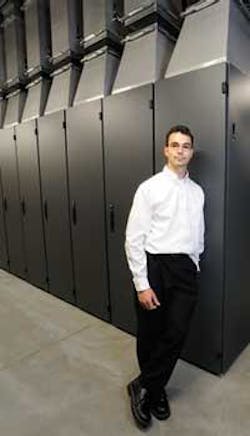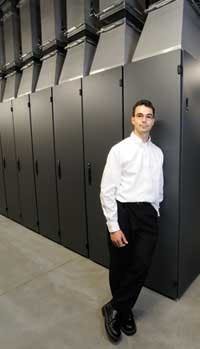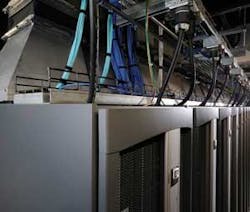Passive cooling solution reduces energy expenses
CDW's new data center in Wisconsin houses cabinets that also provide flexibility and scalability.
CDW Corporation (www.cdw.com) is a leading provider of technology solutions, including unified communications, security, remote managed services, information-worker solutions, and virtualization and optimization. The company's high-tech data centers deliver hosted applications, co-location and managed services to clients nationwide.
To sustain current and future growth, CDW recently built a new enterprise hosting center located just outside of Madison, WI that provides customers with a state-of-the-art facility for securing and managing their mission-critical information technology (IT) infrastructure equipment.
In July 2008, the facility's 34,000-square-foot data center opened, employing energy-efficient solutions that provide 100% uptime via redundant power and cooling infrastructure equipment.
When designing the data center for CDW's new enterprise hosting center, the most important issue to be addressed—next to physical security—was the ability to provide adequate cooling to equipment in an energy-efficient manner. With equipment densities continually increasing and generating more heat per cabinet, CDW sought to locate the ultimate cabinet solution that would provide flexible, safe, and—most of all—effective and resourceful thermal management for their new data center.
Throughout the process, CDW's data center team looked at almost every cabinet manufacturer and evaluated numerous data center cooling techniques. One of the first thermal design concepts assessed included liquid cooling, which was ruled out fairly quickly.
Water worries
We did look into liquid cooling, but had a very uneasy feeling about bringing water into the data center, explains Eric Patterson, CDW's data center manager. When you add liquid cooling within the space, you must include a lot of overhead plumbing. The idea of this made us extremely uncomfortable.
Another design approach that was evaluated included cabinet systems with active exhausts to pull the heat out of the cabinet space. The problem with active exhaust fans is that you are effectively throwing more power into the equation, notes Patterson. Anytime you add more power, you are creating more heat and adding points of failure—and this was something we definitely wanted to avoid.
In addition to finding a cabinet that provided adequate cooling on a slab-floor environment, CDW needed a highly flexible cabinet solution. As a hosting facility, we do not maintain control over what types of equipment will be placed in our cabinets, so we needed something that was very flexible and could accommodate a large variety of manufacturers' equipment, explains Patterson.
When CDW learned about the thermal-management techniques that Chatsworth Products Inc. (CPI) could offer via the F-Series TeraFrame Cabinet System, they were immediately interested. The cabinets, equipped with proprietary CPI Passive Cooling Solutions, presented CDW with all the features and benefits they had set out to find.
The passive cooling abilities found in CPI's F-Series TeraFrame Cabinet fit our requirements perfectly, says Patterson. They encompassed the energy-efficient technology, flexibility, and security we were looking for.
Successful trial
To help finalize their decision, CPI shipped CDW demo F-Series TeraFrame cabinets with CPI Passive Cooling to evaluate and test. We put them in front of our engineers and level one, two, and three folks that rack-test equipment, so they could analyze and test the solutions, Patterson recalls. CPI then worked closely with us to make some very minor modifications and sent us some additional mock units for testing. We were extremely pleased with the results and the top-notch product quality; therefore, we decided to move forward with the F-Series TeraFrame equipped with CPI Passive Cooling Solutions for our new data center facility.
Each of the TeraFrame cabinets is configured with a perforated front door to ensure proper equipment intake airflow, a solid rear door and side panels to prevent hot exhaust air from escaping out the back and sides of the cabinet, and filler panels to eliminate bypass airflow around equipment. In addition, an airflow director is installed to move hot
exhaust air up the back interior part of the cabinet and a modified vertical exhaust duct is located on top of the cabinet system to direct hot exhaust air out of the cabinet space and back to the cooling system.
CDW installed 103 F-Series TeraFrame Cabinets in the first phase of the data center, and plans to use them as additional phases are opened. They are exactly what the data center was designed around, and provide a flexible and scalable cabinet solution with the most-efficient cooling techniques available, says Patterson.
The building is outfitted with a 300-ton rooftop air-conditioning system that cools the entire data center, and two additional units for redundancy's sake. Each exhaust duct is direct-ducted back to the cooling unit, filtered, cooled, and returned to the data center through large ceiling grates. This process, along with CPI Passive Cooling technology, allows CDW to achieve complete airflow isolation, which increases HVAC efficiency, allows higher supply-air temperatures, and decreases energy consumption.
Cool savings
CDW's customers depend on the hosting facility to keep their equipment running at safe operating temperatures with 100% uptime. Not only do CPI's solutions help them achieve these goals, but they also allow CDW to keep supply-air temperatures around 68 to 70° F. Even after the data center is fully populated, it is expected that the supply-air temperature will remain the same.
We have done some initial calculations and estimates to see what kind of savings that CPI's solutions will help us achieve, and have found that using CPI Passive Cooling will save us about 25 to 30% on our energy bill, per fully loaded cabinet, explains Patterson. We expect that it will cost about $1 million in energy charges to run this facility per year, and CPI's solutions should save us about 25 to 30% of that, coming in at about $250,000 to $300,000 savings per year, which presents quite a substantial savings. As the facility grows out and more data centers are added, we may use three, five, or seven million per year in energy, and the savings that CPI Passive Cooling solutions provide will sure add up quickly.
CDW understands that data centers require a lot of power and cooling, which is why these factors became key design considerations when planning their new data center space. This entire facility is powered by solar, wind, and renewable energy, Patterson says. The F-Series TeraFrame Cabinet equipped with CPI Passive Cooling Solutions fit the green direction of this facility, and will contribute to decreased energy consumption—a very important attribute for CDW and today's power-hungry data centers.
NICOLE McLAWHORN is public relations and advertising specialist for Chatsworth Products Inc. (CPI; www.chatsworth.com), where she is involved in marketing communications for CPI's products and solutions.


